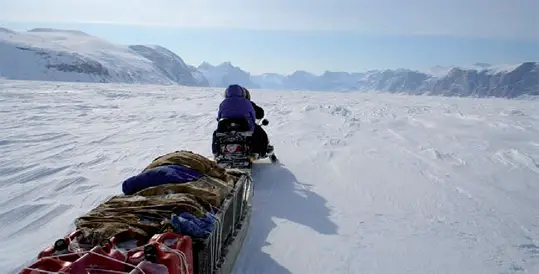Local Observations of Snow Cover Changes
“In many areas of snow cover, there are local people who rely on the snow for water, recreation, travel, and other activities. Through constant and close interaction with snow, these people develop a great body of knowledge about it. People who possess knowledge of snow include mountain villagers, ski patrollers, mountain climbers, and perhaps more than any other group, Arctic residents, especially Indigenous Peoples. These people have the most interaction with snow, as snow is present for most of the year and they depend on it for their livelihoods.
In the Canadian Arctic, Inuit and their ancestors have depended on snow, and held a keen understanding of it, for millennia. Traditionally, Inuit lived in snow houses called igluit. The ability to travel depended partly on the condition of snow cover, for example, hard, soft, deep, or drifted snow. Snow forms on the land or sea ice, running parallel with the dominant wind, helped hunters to navigate; this practice is still used by some today (Figure 4.5). Saami reindeer herders in Fennoscandia have also traditionally depended on snow for their activities and survival. Herders closely observe snow conditions and modify their herding strategies accordingly. For example, in hard snow conditions, herders may keep reindeer close together so that strong animals help to crush icy snow layers, allowing weaker animals to graze. If the snow is relatively soft, animals may be allowed to graze a wider area. Today, Inuit no longer live in snow houses and some Saami employ modern technologies, such as helicopters or motorbikes, to herd reindeer. But elders, and many hunters and herders, still possess traditional knowledge about snow. They constantly gain new knowledge about snow and other aspects of the environment, and incorporate this knowledge into their everyday lives.

Figure 4.5: Arctic Indigenous Peoples have depended on snow for millennia, for example, using snow forms to navigate. This close interaction with snow makes them important observers of snow changes. Photo: Shari Gearheard
Many traditional knowledge holders have noticed snow cover changes in recent years, along with other changes in the environment and climate. In projects such as the Arctic Climate Impact Assessment, scientists have begun working cooperatively with these people in order to understand environmental change in the Arctic. A number of other projects have documented indigenous knowledge of environmental change in the Arctic, primarily in Alaska and the Canadian Arctic. Snow cover changes are a common theme in many of these studies. For example, in Nunavik (northern Quebec), residents observe less snow cover in spring time. This restricts travel into the bush by snowmobile to hunt and collect firewood. Less snow in the hills also means fewer cold storage places for fish, which are kept cool in snow patches. This problem is shared by some communities in the Canadian territory of Nunavut. At Clyde River, Nunavut, Inuit observe that permanent snow patches, aniuvat, are disappearing and at a quicker rate than in the past. In the community of Baker Lake, Nunavut, changes in snow have already had serious consequences. Changes in wind patterns are packing snow harder than normal, making it difficult or even impossible to build snow houses, which are still used for emergency shelters. Weather events seem to be less predictable to elders in the area, and hunters are being caught in unexpected storms unable to make shelter; several deaths in recent years have been blamed on this change in snow.
Communities all over the Arctic are living with environmental change and constantly responding to impacts of this change. Snow changes are only one part of this and local observers in the North will acknowledge that snow is bound in a web of environmental processes that are all connected. Knowledge of snow must be accompanied by knowledge of wind, weather, seasons, animals, ice, water, and ocean currents. With their long history in the Arctic and their continued use of the land, ocean, and ice, Arctic Indigenous Peoples play an important role in understanding the Arctic environment and its changes, including snow changes.”
All Material for this page on Snow Cover Changes is sourced from: United Nations Environment Programme (UNEP), 2007, Global Outlook for Ice and Snow, http://www.unep.org/geo/geo_ice/
See Also
